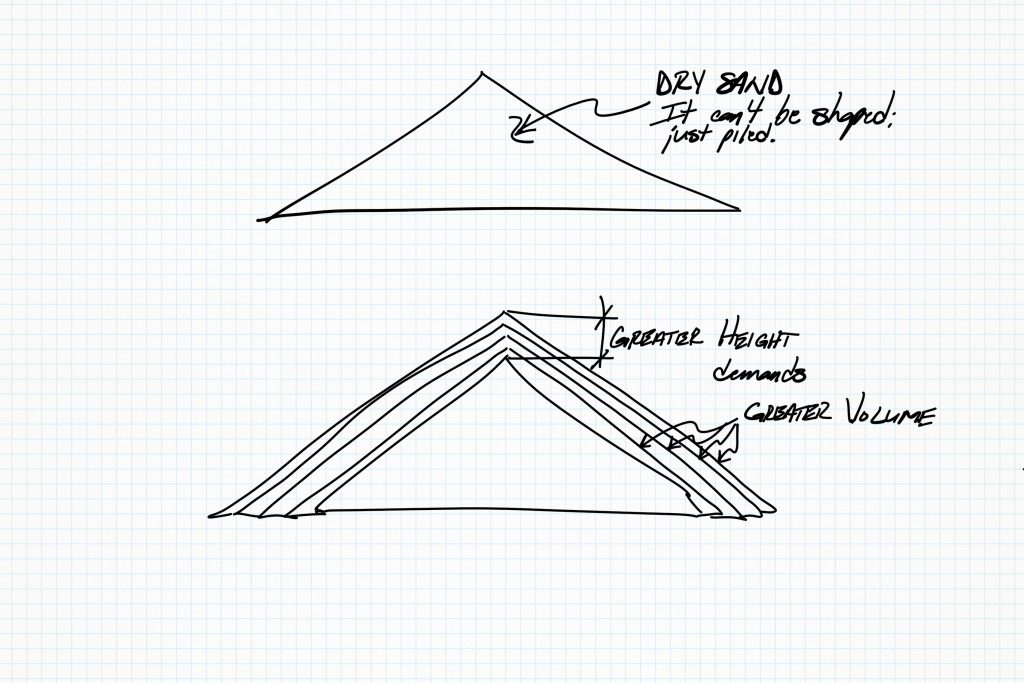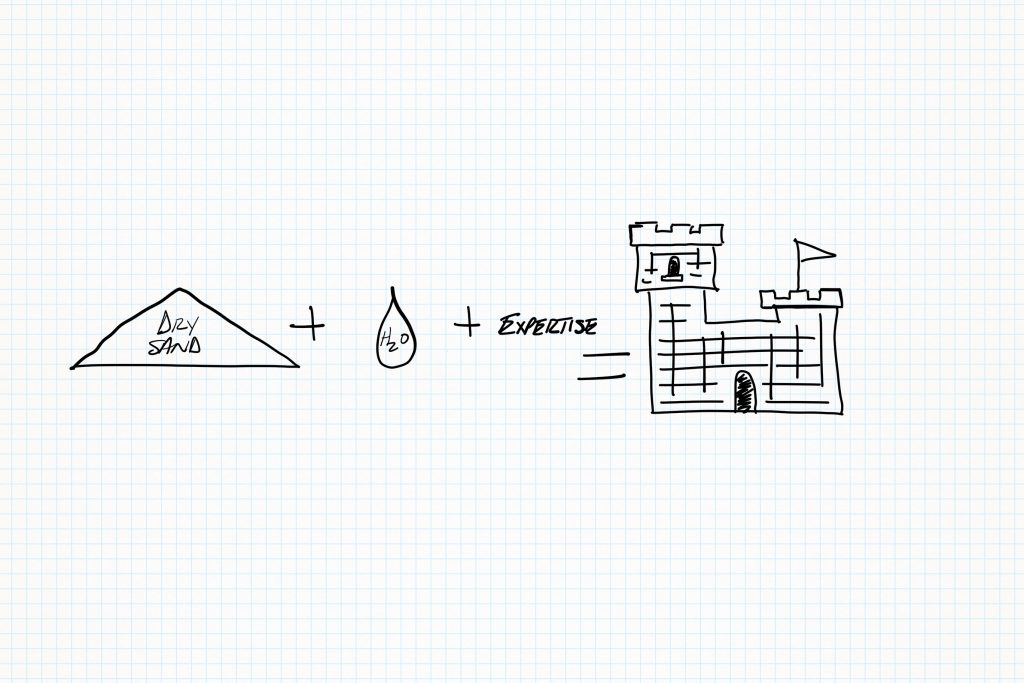Training endurance is like building a sandcastle. You need sand, water, the sense not to overdo it, and both the expertise and creativity to build something great.
Basic endurance is like piling dry sand. It can’t be shaped, just piled higher. For every inch of height, it takes a greater volume of dry sand than the inch before. Adding intensity is like adding water. You can increase the angle of repose of the sand, steepening the cone, getting higher with the same volume. Artists (great coaches) can get the saturation just right, creating amazing sculptures. But those sculptures will always be temporary.
HIIT (high-intensity interval training) proponents misunderstand the sand-to-water relationship. They assume that water is the big secret and conclude that:
- “If water makes sandpiles steeper, let’s just use that!”; and
- “If the pile of wet sand starts to crumble, let’s add more water!”
The critical distinctions to understanding endurance training are:
- First, it’s not either sand or water, but the mix of sand and water that’s important.
- Second, wet sand is born from dry sand; it’s not independent. The volume of dry sand still determines the ultimate height of the cone or and size of the castle.
- Third, if the pile starts to ooze downward, adding more water won’t help. To restore it, you have to dry it out (by adding more dry sand).
The Simplicity of Slow Twitch Endurance
Slow twitch muscle fibers are the main driver in long, easy training sessions. Slow twitch endurance (STE) can increase in two ways: 1) by lengthening the duration of the demands on the fibers; or 2) reducing the fuel available to those fibers. With either method, you need more of the same to create increases in endurance.
STE is a lot like very dry sand. It can’t be sculpted or shaped, only piled higher. The height of the pile is a function of the angle of repose and the volume of sand available. To increase the height of the pile, you need more and more sand.
Now imagine that pile of dry sand as a series of layers. Each layer is a hollow cone, 1 inch thick, nested one inside the other. Every 1-inch cone must be of greater volume to fit over the previous one. Every 1-inch increase in height demands a greater amount of sand than the prior inch required.

The Fun of Fast Twitch Endurance
Thankfully, a second ingredient can boost the performance of slow twitch endurance: fast twitch endurance (FTE).
Fast twitch muscle fibers come alive with intensity, but that intensity is short-lived. To bolster endurance, an athlete must force fast twitch fibers to work longer than they want to. Once these fibers are recruited with a high load, the athlete extends the duration of work to force the fibers to work aerobically.
When building an aerobic sandcastle, FTE is the water. It’s exciting because it reacts quickly and the athlete gets faster sooner.
Seductively, FTE also hints at a more-for-less opportunity: You can make the sandpile taller with the same amount of sand. The angle of repose of wet sand is steeper. By adding water to dry sand, you can steepen the cone and make the pile higher.

But just like trees don’t grow to the sky, fast twitch endurance development can’t be done on its own or forever.
What about Sandcastles?
To build a sandcastle, you need the right amounts of sand, water, and expertise. In endurance training, coaches can get the saturation just right.
They can build sandcastles, but they know that their castles are always temporary. The castles will eventually dry out (or wet out), fall down, and become a pile again.

More Water!
High intensity training is important for improvement, but not in the broader context of where those benefits come from.
If a near-sedentary person starts out with a program focussed around high intensity interval training (HIIT), that broader context doesn’t exist. Without an aerobic foundation, the context is invisible. Left with water and only a small amount of dry sand, they might feel that HIIT (ie, the water) deserves all the credit.
It’s a case of WYSIATI (What You See Is All There Is), which leads to mistaken conclusions.
Bad Conclusion #1: “If water makes sandpiles steeper, let’s just use that!”
Spoiler alert: You can’t build sandcastles with just water.
Focussing on HIIT assumes that intensity is a shortcut around more training volume. This forces a false choice between dry sand and water- as though that wet sand can be drawn from an outside source.
Although a pile of wet sand is steeper than a pile of dry sand, the wet sand can only be born from the dry sand. It’s not independent. So the ultimate height of the wet sand is still limited as a function of what it’s made from.
And if you only have water, and no dry sand, you can’t make anything.
Bad Conclusion #2: “If wet sand starts to crumble, let’s add more water!”
Because the addition of intensity (i.e., “water”) has so much immediate benefit, it’s often assumed that more is better. But just like a pile of sand, adding water helps, but only to a point. It makes the pile steeper, but too much water will turn it into an oozing puddle.
If adding more and more intensity stops working—which it always does—what are they left with?
We can only add more water, or acknowledge that a focus on higher intensity is a wrong choice.
When wet sand starts to lose its structural integrity, adding more water isn’t the solution. Drying it out is. Likewise, when fitness starts to break down, it’s usually from too much intensity. Adding more intensity will make it worse, not better. The solution is to add more “dry sand,” more easy volume.
And that brings us full circle, to the artistry. The best options are seeking out and developing your own knowledge of how aerobic capacity is best developed or outsourcing that knowledge by utilizing a training plan or coach. Because the reality is that only an accomplished artist can get the sand-to-water ratio just right.
This article was originally published by Scott Semple.


4 Comments
Pingback: Lactate Test #3: Moving in the right direction | Redline Alpine
Pingback: Lactate Test #3: Moving in the right direction | Scott Semple
Pingback: Aerobic Capacity: When can I stop easy training? | Scott Semple
Pingback: What is the most important intensity? | Scott Semple